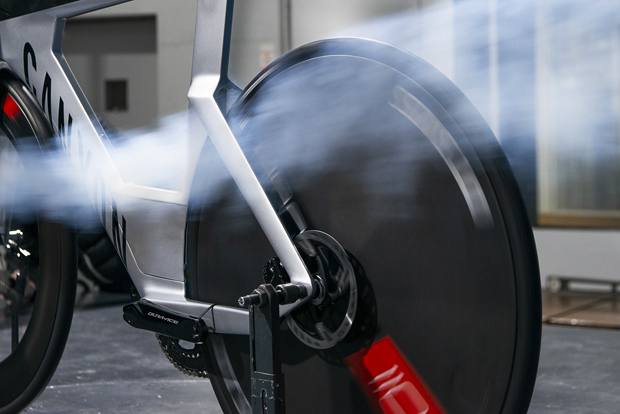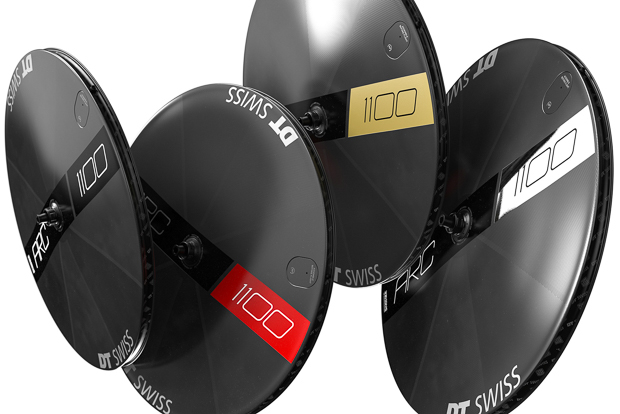As of today, DT Swiss is officially in the market of disc wheels, with the new ARC 1100 DICUT Disc. To be more specific, they actually entered the disc-disc market (cue vinyl record screech).
Before we get too far along, allow me to explain some vocabulary for those that may be new to the sport, or less tech savvy. If you go back about ten, twenty, or thirty years, a disc wheel meant only one thing: a solid rear wheel with no spokes. These wheels are meant to be an aerodynamic upgrade over traditional wheels, because the air can slip past them without being churned up by spokes (plus they can create a sailing effect with the wind that further reduces drag).

These days, there is another piece of disc terminology that’s often thrown around – disc brakes. You may often see the word ‘disc’ attached to wheel product names, which simply denotes that it’s meant for disc brake-equipped bikes.
The new DT Swiss ARC 1100 DICUT Disc ticks both boxes. In other words, it’s an aero disc wheel that’s equipped with disc brakes. The reason I offer this preamble isn’t because DT Swiss is first to market here; it’s just a relatively rare bird even in 2021.
Side note: DT has offered some rim-brake discs in the past, but our sources say that these were made by companies such as Lightweight and Reynolds. This new wheel is, to our knowledge, the first DT-produced disc wheel.

Aero disc wheels have historically been expensive, and have always had a mystique about them. There remains folklore that they must be impossible to ride on anything but a windless day… because I know a guy that knows a guy whose cousin rode a disc wheel into a ditch and burst into flames. In reality, a deep-section front wheel is more difficult to handle than a rear disc. We’ve done our best to educate our readers in countless articles and in our reader forum, but many athletes simply will not ride a rear disc. They opt for a fast – but not as-fast – deep-section rear wheel.

The disc brake disc is even more rare. It has taken quite a while for disc brakes to migrate to triathlon bikes. This is due in part to the way triathlon wheels have been marketed, sold, and used for the last thirty years or so – as a quiver. Invest in a couple sets of good wheels, and you can use them for years and years. Upgraded your bike? No problem – just keep your fast wheels and move them over to your new bike. Many triathletes followed this logic and had a closet full of rim brake wheels. Changing to a disc brake bike requires that you buy ALL new wheels. More athletes are doing this; it’s just not something that happens overnight – especially during economic hardship (and a pandemic that cancelled racing opportunities).

On to the wheel itself, the ARC 1100 DICUT Disc is impressive on paper. It is slightly lighter and pricier than the Zipp Super-9 Carbon Tubeless Disc-Brake Disc, perhaps its closest competitor. It has a 20mm internal rim width (compared to 18mm for the Zipp), and is fully tubeless compatible.

DT lists a tire width range of 25 – 32mm, with 28mm as their optimal recommended choice.

The rim features bead hooks, which act as a failsafe for tire retention at high pressure (and is a requirement for using standard clincher tires – which have beads that are not as stout or inflexible as tubeless tires). DT lists no limitations on tire brand or model with their ARC series wheels. On the topic of rim bead hooks, DT offered the following quote:
“We are convinced that hooked rims are technically the optimal rim construction in terms of safety for bikes that require a relatively high pressure in combination with relatively wide tires.”

The hub internals are DT’s latest 180 DICUT with Ratchet EXP system and ceramic SINC bearings. Note that the disc brake mounting surface uses the Shimano Center Lock standard.

The carbon disc surface was designed in conjunction with DT’s aerodynamic partner, Swiss Side. It includes eight glued carbon pieces of equal size, aligned symmetrically. The overall wheel shape is asymmetric right-to-left, with a flat right side (to make room for the cassette) and slightly convex left side.

DT includes a very cool carbon cover for the valve hole, which opens and closes without tools.

The wheel comes with standard red DT Swiss decals. If red isn’t your thing, they also include gold, black, and chrome stickers with every wheel.

DT performed wind tunnel testing at the GST wind tunnel in Immenstaad to put some numbers behind their product. The wheels were mounted in a 2021 Canyon Speedmax (size M). DT provided these additional details:
“For the analysis of the wheels in the wind tunnel, we use a weighting system based on extensive real-world measurements and statistical evaluations of weather data. It takes into account that frontal airflow (0°yaw) occurs more frequently and is weighted more strongly than crosswind (up to 20 degrees yaw). This weighting system is very similar to the weighting system used by the leading European cycling magazines in their product tests.”

DT Swiss claims an improvement of 1.8 watts for the disc wheel over their own ARC 1100 DICUT 80. When compared to the Zipp Super 9 Disc, they quote an improvement of 2 watts.

Is the ARC 1100 DICUT Disc for you? I haven’t had a chance to ride the wheel, and it’s light-years out of my price range, so it’s hard to say. On paper, it ticks just about all of the boxes I’d look for, if I had to choose one disc-brake-disc. I like the 20mm internal rim width, the lack of tire restrictions, the weight, the brake compatibility (Center Lock), and DT’s typically very high build quality. If that’s what you’re looking for, I think it would be hard to find something better.
DTSwiss.com



